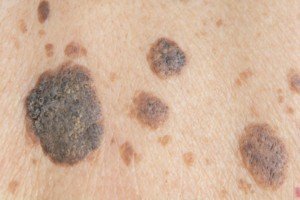
If you’ve noticed dozens of new moles over only a few months, you’ll want to bring this to the attention of a dermatologist if you’re worried about melanoma.
Dozens of new moles in only a few months does not mean you have melanoma.
But you may be wondering if dozens of brand-new moles appearing over a few months may mean a higher risk of melanoma, a most ruthless cancer.
Well, the new appearance is “usually not normal,” says Dr. Jennifer Gordon, MD, who is board certified by the American Board of Dermatology and who practices at Westlake Dermatology located in Austin, Texas.
But don’t panic.
First off, try to make sure that what you’re seeing, that’s appeared over the past few months, are actually new moles.
New Mole Confirmation
Dr. Gordon says that “many things look like moles but are not that can occur in crops and arise quickly: freckles, keratoses, etc.).”
Keratoses are benign skin growths that can look very much like moles.

Seborrheic keratoses
“If true moles arise quickly, then it may mean an alteration in your immune system, a change in hormones or possibly other systemic or genetic conditions,” explains Dr. Gordon.
“Often there is a genetic predisposition to number of nevi [moles] or propensity to develop them.
“Typically they occur starting at a young age, and a person continues to make new moles, and moles can grow with a person until their 30s.”
Newly appearing spots, that look like moles, in middle age are not necessarily melanoma — they are usually benign nevi — but should be examined by a dermatologist.
“Both genetics and UV light play a role in forming nevi so there can be moles ‘where the sun don’t shine’ as well as having certain areas with more moles than others,” says Dr. Gordon.
“In general, a higher number of nevi correlates to a higher risk of melanoma, but this is not the only factor.
“If dozens of moles or other pigmented lesions occur within a short amount of time, it is always a good idea to see your dermatologist.”

Dr. Gordon’s interests include medical dermatology, particularly the treatment and prevention of melanoma and other skin cancers in athletes. For 2016, 2017 and 2018 Texas Monthly Magazine selected her as one of the Texas Super Doctors Rising Stars.
 Lorra Garrick has been covering medical, fitness and cybersecurity topics for many years, having written thousands of articles for print magazines and websites, including as a ghostwriter. She’s also a former ACE-certified personal trainer.
Lorra Garrick has been covering medical, fitness and cybersecurity topics for many years, having written thousands of articles for print magazines and websites, including as a ghostwriter. She’s also a former ACE-certified personal trainer.
.











